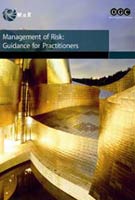
 Managing
Successful Programmes. 2007 Edition. Office of Government Commerce (OGC) .
2007. Combining rigor and flexibility, MSP helps all organizations - public
sector and private, large and small - achieve successful outcomes from their
program management time and time again. With change a pressing reality for
all organizations, successful program management has never been more vital
to success. Organizations must respond as new processes or services are
introduced, supplier relationships alter and structures adapt to market
forces or legislation.
Managing
Successful Programmes. 2007 Edition. Office of Government Commerce (OGC) .
2007. Combining rigor and flexibility, MSP helps all organizations - public
sector and private, large and small - achieve successful outcomes from their
program management time and time again. With change a pressing reality for
all organizations, successful program management has never been more vital
to success. Organizations must respond as new processes or services are
introduced, supplier relationships alter and structures adapt to market
forces or legislation.
At the same time, all organisations strive to achieve excellence by improving practices, offering better services, preparing more effectively for the future and encouraging innovation. But change always creates new challenges and risks. Inevitably there will be interdependencies to manage and conflicting priorities to resolve as the organisation adapts not just to a new situation internally but to the constantly shifting world outside.
To enable organisations to manage their programmes successfully, they need a structured framework that does two things. It must acknowledge that every programme exists in its own context and demands unique interpretation. At the same time it must be universally applicable. MSP has been developed with these two priorities in mind. Its framework allows users to consistently manage a huge variety of programmes so that they deliver quality outcomes and lasting benefits. Fusing leadership with management best practice, MSP enables organisations to coordinate their key functions, develop a clear sense of unity and purpose and achieve the strategic cohesion necessary to drive through effective change.
Key features:
258 pages. ISBN 10: 0113310404; ISBN 13: 9780113310401. paperback, $99.00
 Management
of Risk: Guidance for Practitioners. 2007 Edition - 2nd Impression with
Corrections. Office of Government Commerce (OGC). 2007. Every
organisation must find the right balance between opportunities and
threats in managing its risks. M_o_R takes a best practice approach,
which offers a structured and effective framework for risk management.
Its aim is to help organisations to achieve their objectives by first
identifying the risks, and then choosing the right response to the
threats and opportunities that are created by uncertainty. This
publication is invaluable across all organisational activities from
strategic, programme, project or operational perspectives.
Management
of Risk: Guidance for Practitioners. 2007 Edition - 2nd Impression with
Corrections. Office of Government Commerce (OGC). 2007. Every
organisation must find the right balance between opportunities and
threats in managing its risks. M_o_R takes a best practice approach,
which offers a structured and effective framework for risk management.
Its aim is to help organisations to achieve their objectives by first
identifying the risks, and then choosing the right response to the
threats and opportunities that are created by uncertainty. This
publication is invaluable across all organisational activities from
strategic, programme, project or operational perspectives.
Providing a route map for risk management, M_o_R brings together key principles, a recommended approach, a set of inter-related processes and pointers to more detailed sources of advice on risk management techniques and specialisms. It also shows how the guidance should be embedded, reviewed and applied differently depending on the nature of the objectives at risk.
The 2007 edition is a major refresh of the M_o_R guidance written in 2002. The framework has been strengthened in the following areas:
169 pp. paperback. ISBN 0113310382; 978113310388. $99.00
IS Management Guides.
Together, the
IS Management and Business Change guides offer a full spectrum of guidance
on business change issues, from setting direction through organizational
change to assessing performance, as well as guidance on acquiring and
managing major services. These practical,
easy-to-read guides help managers make informed decisions about business
change, performance, managing services and strategic management. Produced
by the OGC, the government department responsible for ensuring projects run
efficiently, the IS Management and Business Change Guides provide
invaluable real-world experience in government and beyond. Each guide is
structured in a clear, step-by-step way that sets out the issues, questions
and techniques relevant to each stage. The Guides
are now available as a series in paperback or CD-ROM format.
*IS management and business change guides complete
set.
OGC. 2002.
OGC. 2002.
Printed 5-volume set: ISBN
1 90 309129 2 $200.00
CD-ROM 5-volume set:
ISBN 1 90 309130 6 $611.00
 How to Manage
Business and IT Strategies.
How to Manage
Business and IT Strategies.
OGC. 2002.
IT is a key part of today's business
planning, whether it is used for managing business information or supporting
new services to customers. This guide discusses IT in business terms as a
means of improving services and reducing costs. This title provides
business-focused advice on 'joining up' your organization's IT services with
those of other organizations and describes a governance framework that
supports the strategic decision-making process. As a result of reading this
guide, you should be able to: Draw up strategies that are flexible enough to
deal with an uncertain future • Set and manage a strategic direction for
your organization that makes best use of IT • Develop a governance
framework that covers the policies needed for all aspects of managing IT •
Understand and meet the IT-related needs of key stakeholders. Paperback, 100
pp.
Print: ISBN 1
90 309102 0 $50.00
CD-ROM: ISBN 1
90 309116 0 $125.00
 How
to Manage Business Change.
How
to Manage Business Change.
OGC. 2002.
Business change, whether planned or
unplanned, must be managed if the organization is to benefit. This guide
explains how to manage the key components of business change - the
organization, its people, the technology and the external business
environment. It also describes the process of managing business change, from
the strategies behind it through to new ways of working and the realization
of benefits. There is advice on managing the 'people' issues, which
typically consume 80% of the resources required for business change. This
guide outlines the programme management process described in detail in the
companion OGC guidance on PRINCE and Programme Management and Risk. As a
result of reading this guide, you will be able to: Identify opportunities
for business change that are realistic and achievable and make informed
choices in prioritizing these opportunities • Reduce risk and uncertainty
about the future • Manage the expectations of staff, customers and other
stakeholders • Manage the interdependencies between the organization's
structure, its people, its technology and changes in the external
environment • Manage, realize and achieve the benefits expected from
business change • Manage the transition to new ways of working. Paperback,
100 pp.
Print: ISBN 1
90 309110 1 $50.00
CD-ROM: ISBN
1 90 309114 4 $125.00
 How
to Manage Performance.
How
to Manage Performance.
OGC. 2002.
Most organizations seek year-on-year
improvements as part of their key business targets. This guide (developed in
collaboration with the National Audit Office) explains the principles of how
to manage your organization's performance by looking to the future as well
as measuring your past performance. It describes a performance management
framework and techniques for measuring your performance (including the
contribution of IT to the business), and identifies the techniques that will
help you to achieve improvements. As a result of reading this guide, you
will be able to: Position your organization for continuous improvements •
Identify the areas in your organization where improvements would do the most
good • Draw up a performance management framework that deals with the
priorities for your organization • Establish performance measures that
relate to your business objectives and intended outcomes. Paperback, 100 pp.
Print: 1 90
309113 6
$50.00
CD-ROM: ISBN 1
90 309122 5 $125.00
 How
to Manage Service Acquisition.
How
to Manage Service Acquisition.
OGC.
2002.
Acquiring services from private sector providers can bring economy,
flexibility and innovation to public sector organizations, supporting the
business and allowing a better focus on key activities. The process of
acquiring services must be managed to ensure that services help the
organization achieve its strategic goals, and that value for money is
obtained throughout the life of the contract. This guide provides an
overview of the process of acquiring a major service, from looking at
strategic aims, through determining requirements, the formal procurement
process and implementation, and recompetition at the end of a contract. It
also briefly covers the important factors in making a commercial arrangement
work, both in formal governance and the relationship between customer and
provider. This guide complies with the principles of HM Treasury's Green
Book and EC procurement rules. Paperback, 100 pp.
Print: ISBN 1
90 309111 X $50.00
CD-ROM:
ISBN 1 90 309121 7 $125.00
 How
to Manage Service Provision.
How
to Manage Service Provision.
OGC. 2002.
Managing providers and services is all about
achieving a realistic balance between what the business wants and what the
provider can deliver while maintaining value for money. This guide describes
the main components of service management from a business point of view:
managing service performance, the working relationship, the contract and
changes to requirements. It also provides an outline of the service
management tasks that should be carried out by the provider on the
customer's behalf. As a result of reading this guide, you will be able to:
Identify the critical success factors for effective service management •
Manage service performance and quality against what was agreed in the
contract • Decide on appropriate arrangements, both formal and informal,
for managing the every day working relationship • Deal with planned and
unplanned changes to requirements. Paperback, 100 pp.
Print: ISBN 1 90 309112 8
$50.00
CD-ROM: ISBN 1
90 309115 2 $125.00
 In Times of Radical Change.
In Times of Radical Change.
The business perspective on your IT infrastructure.
Brian Johnson, John Stewart &
Rene van Veen, CCTA. 1997.
Paperback, 208 pp.
ISBN 0 11 330687 3 $100.00
Understanding
and Improving.
Arnold van Marmeren, Rene
van Veen & John Stewart, CCTA. 1996.
With correction slip dated November
1996. This is one of 3 guides in the series "The Business perspective
on your IT infrastructure" from the IT infrastructure library.
Paperback, 190 pp.
ISBN 0 11 330679 2 $92.00
Back to Home | Company Info | Ordering | Shipping & Tracking | Publishers | Meetings | Search | Site Index | Feedback